Previous Paper
IGNOU B.Ed. Entrance Test 2007
PART-A
SECTION-I GENERAL ENGLISH COMPREHENSION
Directions: Read the following passage carefully and pick out the best answer out of the four choices given in the question that follow.
Motivations for ruralism in underdeveloped countries are understandably different from those in developed counties. There, it is a sheer physical necessity for the very action of human survival. In the Third World countries, which are predominantly rural, the only lever that can lift human life above its present subhuman level, is rural development. Rural life in such countries has been stagnating for centuries. Nothing worthwhile has been done to ameliorate the conditions of the rural population which is only slightly different from that of their quadruped counterparts. Ignorance, ill-health and poverty have become synonyms of rural life in the undeveloped and underdeveloped countries. But the worst tragedy is that the concerned human populations have taken his state of affairs for granted, as something unalterable, something for which there is no remedy. Every ray of hope has gone out of their lives. In such countries, rural development is the inevitable condition of any material or non-material advancement. As such, enlightened sections of all such countries have been taking an ever growing interest in the question of rural development.
This was also a part of the legacy of their freedom struggle. IN countries like India, it is well known that attempts at rural development were an inseparable part of the independence movement. Leaders like Gandiiji realised quite well that Real India lived in her stagnating villages. Cities, which were mostly the products of Western colonialism, were just artificial showpieces. Even then there were two
Worlds. The posh areas, where the affluent few, mostly the products and custodians of imperial interest lived, were little islands engulfed by he vast ocean of dirt, represented by the vast majority of people.
Cities were by no mean unknown to India. In ancient India, they were integral parts, organically related to the rest of the country and society. Cities in ancient India were flowers of the cultural and artistic excellence of the nation, modern cities are just parasites, preying on and debilitating the country.
Hence, Gandhiji started the ‘Go to Village Movement’ which along, according to him could bring freedom to India and sustain it. Rural development had the place of pride in his strategy for the nations’s freedom. Thus, it had its origin in the freedom struggle.
1. People are taking greaer interest in rural development because:
(A) they have realized the indispensability of it
(B) they have been suffering from severe health problems
(C) nothing worthwhile can be done in the near future
(D) they have now become optimistic about it
2. Which of the following is the ‘lever’ according to the passage?
(A) Non-material advancement
(B) Stagnation of rural life
(C) Upliftment of the rural masses
(D) Enlightenment of certain sections of the society
3. Which of the following is the worst tragedy according to the author?
(A) The subhuman condition of the people in villages
(B) The pessimism of the rural people about their own condition
(C) Lack of realization of the importance of rural development
(D) Exploitation of rural people by city dwellers
4. Which of the following statement is not true in the context of the passage?
(A) Rural folk in the Third World countries feel that their subhuman condition cannot be changed.
(B) Only rural development can raise the standard of living of the people in Third World countries.
(C) Most of the rich people living in modern cities are genuinely concerned about rural development.
(D) Rural development is a prerequisite for any other advancement and progress.
5. Rural development was considered as a part of India’s freedom movement because:
(A) Imperial interest lived only in villages
(B) The country comprised of mainly villages
(C) Gandhiji was against Western colonialism
(D) Real India was then under the British rule
6. The Standard of living of human beings in Third World counties is:
(A) improving very rapidly
(B) immune to any improvement
(C) subhuman despite best efforts for improvement
(D) not far better than that of animals
7. Which of the following, best describes the two divergent worlds of modern cities?
(A) A few rich people and many poor people
(B) Posh area and affluent people
(C) Commercial and industrial exploitation
(D) Patrons of Western products and custodians of imperial interests.
8. Which of the following statements is true in the context of the passage?
(A) Most Third World countries are undergoing fast urbanisation
(B) India’s struggle for freedom has been considered as a part of rural development.
(C) Rural folk are very optimistic about improvement in their condition.
(D) In the present context, ignorance, poverty and ill-health are inseparable parts of rural life.
9. Choose the expression which is closest in meaning to ‘Predominantly’ as used in the passage.
(A) weakly
(B) undoubtedly
(C) scarcely
(D) in a greatly visible way
10. Choose the word that is opposite in meaning to ‘Ameliorate’ as used in the passage.
(A) worsen
(B) lessen
(C) expedite
(D) hasten
SECTION II : LOGICAL AND ANALYTICAL REASONING
Directions (11-14) : Read the passage to answer the question that follow.
There is a cube with six surfaces painted Red, White, Blue, Yellow, Black and Green in such an order that Black is at the top face, Green is bottom and the other four colours are arranged in the order given in an anticlockwise direction of the surfaces. Now answer the following questions (11-14), if Red is towards you.
11. If the cube is rotated horizontally first by 180°, then which colour would be facing downward?
(A) White
(B) Blue
(C) Yellow
(D) Black
12. If the cube is rotated clockwise (right to left) horizontally by 180° from initial position and then rotated upwardly by 90°, then which colour of the cube would be facing you?
(A) Green
(B) Red
(C) Blue
(D) Black
13. In the above question (12) which colour would be facing on the left side of you?
(A) Red
(B) Green
(C) White
(D) Yellow
14. Which colour(s) would be bounded by Yellow, Green and White?
(A) Red
(B) Blue
(C) Red and Blue
(D) Red and Yellow
Directions (15-18) : In the following diagram square stands for those who take tea, triangle stands for those who take coffee, circle stands for those who take cold drinks. Study the diagram carefully to answer the questions (15 -18) that follow.
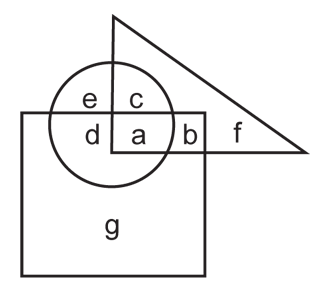
15. The persons who take tea and coffee but do not take cold drinks represented by which letter?
(A) a
(B) b
(C) c
(D) d
16. The persons who take tea and cold drinks but do not take coffee are represented by which letter?
(A) a
(B) b
(C) c
(D) d
17. The persons who take tea, coffee and cold drinks are represented by which letter?
(A) a
(B) b
(C) c
(D) d
18. The persons who take cold drinks and coffee but do not take tea are represented by which letter?
(A) a
(B) b
(C) c
(D) d
Directions (19-22) : In the following questions an incomplete series with one blank is given. Find out the best suited missing number from the given alternatives.
19. 1, 4, 8, 11, 15, ?, 22
(A) 19
(B) 18
(C) 17
(D) 20
20. 1, 4, 9, 16, ?
(A) 23
(B) 24
(C) 25
(D) 30
21. 1, 3, 7, 15, 31, ?
(A) 62
(B) 63
(C) 61
(D) 71
22. 1, 2, 6, 24, ?
(A) 120
(B) 144
(C) 30
(D) 140
Directions (23-26) : In each of the following questions there are five figure. First is a reference figure. Among the best four figures one figure does not belong to a class to which first figure belongs. Identify this odd figure.
23. 
(A) 
(B) 
(C) 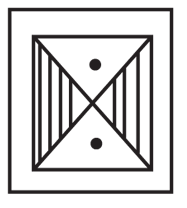
(D) 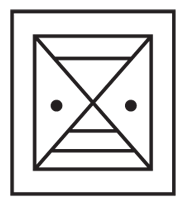
24. 
(A) 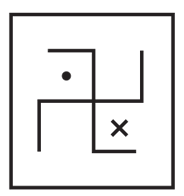
(B) 
(C) 
(D) 
25. 
(A) 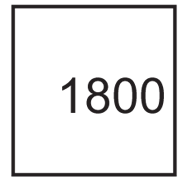
(B) 
(C) 
(D) 
26. 
(A) 
(B) 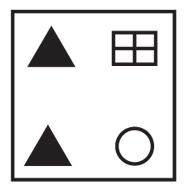
(C) 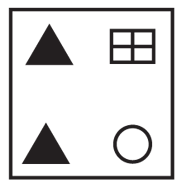
(D) 
Direction (27-30) : In each of the following questions, two statements ar followed by two conclusions. Assuming the first two statements to be true (however absurd they may be), decide which of the two follows logically from the given statements. Select the most appropriate alternative from the ones given.
27. All boys are not students.
Some students are not employed.
Conclusions:
I. Some boys are not employed.
II. Some employed ones are not boys.
(A) Only I follows
(B) Only II follows
(C) Both I and II follow
(D) Neither I nor II follows
28. All animals are dogs.
All cats are animals.
Conclusions:
I. Some boys are not employed.
II. Some employed ones are not boys.
(A) Only I follows
(B) Only II follows
(C) Both I and II follow
(D) Neither I nor II follows
29. All chairs are pens.
All pens are pencils.
I. Some pencils are chairs.
II. All chairs are pencils.
(A) Only I follows
(B) Only II follows
(C) Both I and II follow
(D) Neither I nor II follows
30. No men are animals.
Some animals are intelligent.
Conclusions:
I. Some men are not intelligent.
II. Some intelligent beings are men.
(A) Only I follows
(B) Only II follows
(C) Both I and II follow
(D) Neither I nor II follows
SECTION III: EDUCATIONAL AND GENERAL AWARENESS
31. The first woman president of the Indian National Congress was:
(A) Sucheta Kriplani
(B) Rajkumari Amrit Kaur
(C) Annie Besant
(D) Sarojini Naidu
32. The earliest inscriptions on stone in India were in which language?
(A) Prakrit
(B) Pali
(C) Sanskrit
(D) Brahmi
33. Railways were introduced in India when the Governor General of India was:
(A) Curzon
(B) Dalhousie
(C) Hardinge
(D) Ripon
34. What should be given to an athlete for instant energy?
(A) Carbohydrates
(B) Protein
(C) Fat
(D) Vitamins
35. The place in India receiving the lowest rainfall is:
(A) Leh
(B) Jaisalmer
(C) Bikaner
(D) Jodhpur
Answer: (B)
[/bg_collapse]
37. Earthquake is measured by using:
(A) Barometer
(B) Laser rays
(C) Seismograph
(D) Altimeter
38. Mudaliar Commission (1952-53) had recommended opening of:
(A) Kendriya Vidyalayas
(B) Multipurpose Secondary Schools
(C) Navodaya Vidyalayas
(D) Vocational Institutes
39. Emphasis on Common School System was first laid by:
(A) Radhkrishnan Commission (1949)
(B) Mudaliar Commission (1953)
(C) Kothari Commission (1966)
(D) National Policy on Education (1986)
40. The first committee which looked into the problem of wastage and stagnation at primary stage was:
(A) Hartog Committee
(B) Sri Prakaash Committee
(C) Zakir Hussain Committee
(D) Ram Murti Committee
41. “Give me blood and I promise you freedom” was uttered by:
(A) Bhagat Singh
(B) Chandrashekhar Azad
(C) Sardar Patel
(D) Subhash Chandra Bose
42. Which of the following is not the principle of Panchsheel?
(A) Non-alignment
(B) Peaceful co-existence
(C) Non interference in each others international affairs
(D) Mutual respect for each others territory and sovereignty
43. In India, diamonds are found at:
(A) Panna (Madhya Pradesh)
(B) Golkunda (Andhra Pradesh)
(C) Khetri (Rajasthan)
(D) Gulbarga (Karnataka)
44. The first free and private university in India, completely indepe3ndent of Government and receiving no grant from it, was:
(A) Banaras Hindu University
(B) Aligarh Muslim University
(C) Women’s University, Pune
(D) Vishwa Bharati, Shantiniketan
45. ‘Pakistan Papers’ has been authored by:
(A) Brig. H. S. SOdhi
(B) K. K. Bhargava
(C) Dr. Sadiq Hussain
(D) Mani Shankar Aiyar
46. Which city will host 2010 Commonwealth Games?
(A) London
(B) New Delhi
(C) Paris
(D) Melbourne
47. Harita Kaur was the distinction of being first Indian woman:
(A) Doctor to create a test tube baby
(B) Pilot to fly an aircraft solo
(C) Induced in Indian Navy
(D) Employed in a petrol pump
48. Silver is most abundantly found in the state of:
(A) Bihar
(B) Tamil Nadu
(C) Rajasthan
(D) Karnataka
49. Which of the following is wrongly matched?
(A) Television – Baird
(B) Transistor – Shockley
(C) Typewriter- Sholes
(D) Thermometer-Celsius
50. The Chief Election Commissioner of India is:
(A) elected by the Parliament
(B) nominated by the Prime Minister
(C) appointed by the President of India
(D) appointed by the Ministry of Parliamentary Affairs
Directions: Indicate the correct answer.
51. Agha Khan Palace, where Kastuba Gandhi died while under detention along with Mahatma Gandhi is at:
(A) Bombay
(B) Pune
(C) Ahmedabad
(D) Bangalore
52. Wular Lake is in the state of:
(A) Orissa
(B) Gujarat
(C) Jammu & Kashmir
(D) Madhya Pradesh
53. Mandal Panchayats were recommended by:
(A) Ashok Mehta Committee
(B) Balwant Rai Mehta Committee
(C) Narsimhan Committee
(D) Sarkaria Commission
54. The Indian constitution is divided into how many parts?
(A) 22
(B) 20
(C) 18
(D) 16
55. According to U. N. Convention on the ‘Rights of the Child’ which of the following is not correct?
(A) Safe drinking water
(B) Adequate standard of living
(C) Employment
(D) Protection from exploitation
SECTION IV : TEACHING-LEARNING AND THE SCHOOL
Directions: Indicate the correct answer.
56. The concept of Basic Education was given by:
(A) Dr. Zakir Hussain
(B) Dr. Rajendra Prasad
(C) Mahatma Gandhi
(D) Rabindranath Tagore
57. The most important indicator of the quality of school education is:
(A) infrastructure facilities in schools
(B) textbooks and teaching-learning material
(C) classroom processes
(D) attainment level of children
58. Student’s learning difficulties can be best addressed by:
(A) advising them to work hard
(B) suggesting private tuitions
(C) supervised study in the library
(D) remedial teaching
59. ‘Inservice teachers’ training can be made effective by:
(A) using training package developed in advance
(B) making it residential
(C) using participatory approach
(D) putting follow up mechanism in practice
60. Anti-child labour law (1986):
(A) prohibit all forms of child labour until the age of 14 years
(B) prohibits child labour in hazardous occupations only
(C) prohibits child labour during school hours
(D) prohibits child labour by putting responsibility on the employers about their education.
61. For being successful in life, students should be encouraged to:
(A) selective study
(B) casual study
(C) intensive study
(D) learning by rote memorization
62. Student’s absenteeism should:
(A) be the concern of headmaster and parents
(B) be dealt with by school authorities as per the rules
(C) be taken up seriously by the teachers
(D) be accorded less priority as against those present in the class
63. Organization of co-curricular activities should be the responsibility of:
(A) the headmaster
(B) the teacher appointed for this purpose
(C) teachers interested in it
(D) all the teachers
64. Students who bring out alternative solutions and cite the books not prescribed by the teacher should be:
(A) discouraged
(B) encouraged
(C) advised to talk to the teacher outside the class
(D) advised to follow the class notes to score better in the examinations
65. Experienced teachers don’t require detailed planning for a lesson because:
(A) they can teach better without it
(B) inquisitive students are only few
(C) they don’t face any challenge even in some mistakes are committed
(D) they can manage with brief outline using their expertise gained so far
66. Education should aim at:
(A) developing vocational skills among students
(B) developing social awareness among students
(C) preparing students for examinations
(D) preparing students for life
67. Best way of homework checking is:
(A) getting it done through bright students
(B) getting the answers checked collectively in the class
(C) getting it checked on sample basis
(D) getting checked by teacher her/himself regularly
68. Periodic tests be given to students to:
(A) inform students progress to their guardians
(B) undertake the exercise as required under rules
(C) train students for final examinations
(D) take corrective measures on the basis of feedback from the results
69. Student’s failure should be considered as:
(A) failure of the system
(B) failure of the teacher
(C) failure of textbooks
(D) failure of individual student
70. Training needs of teachers can be identified realistically by:
(A) asking teaches about it
(B) asking the supervisors of teachers
(C) analyzing teacher profiles
(D) analyzing pupil achievement data
71. Problem of school dropouts can be effectively tackled by:
(A) reducing curriculum load
(B) teachers empathy
(C) attractive school environment
(D) providing incentives
72. An ideal teacher is one who:
(A) covers the full course
(B) helps students in learning
(C) is a fired, philosopher and guide
(D) likes discipline
73. Public Examination System should continue because :
(A) it is good for comparison
(B) it has greater acceptability
(C) it promotes teaching-learning in schools
(D) teachers are no t trustworthy
74. A committee to review the National Policy on Education (1986) was headed by:
(A) Ramamurti
(B) P. C. Alexander
(C) Chitra Naik
(D) P. C. Chunder
75. Teacher motivation and commitment can be enhanced by:
(A) offering them high salaries
(B) providing inservice training
(C) allowing them private tuitions
(D) providing them professional support on the basis of monitoring results
76. An essential component in the curriculum for out of school children should be:
(A) literacy skills
(B) life skills
(C) numeracy skills
(D) vocational skills
77. Tax payers are contributing towards Elementary Education by paying:
(A) income tax
(B) tuition fees
(C) for private tuitions
(D) education cess
78. Education of girls needs to be given priority because:
(A) girls happen to be more intelligent than boys
(B) girls are less in number than boys
(C) girls have been discriminated against boys in the past
(D) girls only can lead social change
79. Success of inclusive education depends on:
(A) community support
(B) high quality teaching-learning materials
(C) high quality textbooks
(D) attitudinal change among teachers
80. Quality of school educations depends heavily on:
(A) Infrastructure facilities
(B) Financial provisions
(C) International support
(D) Quality of teacher education
PART-B
SECTION V : (I) SCIENCE
81. Which of the following colours has the shortest wavelength?
(A) Red
(B) Orange
(C) Yellow
(D) Violet
82. In a diesel engine, the fuel is ignited by:
(A) a spark plug
(B) liquid oxygen
(C) the heat generated when air is compressed in the cylinder
(D) vaporization under partial vacuum
83. How many moons does the Pluto have?
(A) None
(B) One
(C) Two
(D) Six
84. The weight of a body on the moon is:
(A) 1/5th of its weight on earth
(B) 1/6th of its weight on earth
(C) 1/7th of its weight on earth
(D) 1/100th of its weight on earth
85. The scientific study of the action of chemical upon living beings is called:
(A) Pharmacy
(B) Pharmacognosy
(C) Pharmacology
(D) Biochemistry
86. In the manufacturing of match stick, which of the following is used?
(A) Potassium
(B) Sodium
(C) White phosphorus
(D) Red phosphorous
87. What did Fleming discover?
(A) Vitamin A
(B) Vaccines
(C) Sulphonamides
(D) Penicillin
88. The substance present inside a fluorescent tube which emits light is:
(A) Nitrogen
(B) Mercury vapour
(C) Sodium cyanide
(D) Air
89. The biological process by which changes occur in genes is known as:
(A) Adaptation
(B) Evolution
(C) Natural selection
(D) Mutation
90. Agronomy is the study of:
(A) behavior of agricultural animals
(B) field crop production and soils
(C) names of agricultural plants
(D) all of these
91. Cold-blooded animals are those animals whose:
(A) blood is cold
(B) blood is blue, not red
(C) body temperature varies with that of the surroundings
(D) body temperature is always constant
92. What I s the technical term for fish farming?
(A) Aviculture
(B) Sericulture
(C) Pisciculture
(D) Zooculture
93. The vision defect of eyes as a result of which a person is unable to see distant objects clearly, is called:
(A) Hypermetropia
(B) Long sightedness
(C) Astigmatism
(D) Myopia
94. Which of the following diseases is caused by amoeba?
(A) Paralysis
(B) Cholera
(C) Dysentery
(D) Typhoid fever
95. The wind blowing from the land towards the sea during the night is known as:
(A) Ordinary breeze
(B) Sea breeze
(C) Land breeze
(D) Cold breeze
96. Dots are placed on dice in such a fashion that the sum of dots on any two opposite sides is always:
(A) 9
(B) 7
(C) 6
(D) 8
97. If the earth did not spin:
(A) we would have no seasons
(B) half of earth would always be in sunlight
(C) there would be no summer in the northern hemisphere
(D) all of the above
98. The most abundant element in the earth’s crust is:
(A) Oxygen
(B) Silicon
(C) Aluminium
(D) Iron
99. The term Green Revolution refers to:
(A) increase in milk production
(B) increase in vegetable production
(C) involvement of Dr. Green in agriculture
(D) increase in crop production
100. When a person donate blood, approximately how much of his/her blood is taken?
(A) 250 – 300 ml
(B) 1000 ml
(C) 1 – 2 litre
(D) 50 ml
(II) MATHEMATICS
101. The value of :
 is
is
(A) 0
(B) 1
(C) a
(D) 2 + a
102. If p = x + y and q = x – y, then the expression ![]() has a value:
has a value:
(A) ![]()
(B) ![]()
(C) ![]()
(D) ![]()
103. One-third of a number is greater than one-fourth of its successor by one. The number is:
(A) 27
(B) 39
(C) 15
(D) 18
104. When the repeating decimal 0.363636 ….. is written in simplest fractional form, the sum of numerator and denominator is:
(A) 135
(B) 114
(C) 45
(D) 15
105. A number of persons paid equal amounts and collected Rs. 72. If there were 3 persons less, then each would have to contribute Rs. 4 more. The number of people was:
(A) 12
(B) 9
(C) 36
(D) 6
106. A sum of Rs. 61 is divided among, A, B, and C. A gets twice as much as B and C gets Rs. 5 less than A and B together. The amount that C gets is:
(A) Rs. 22
(B) Rs. 33
(C) Rs. 28
(D) Rs. 11
107. 4% of 2.5 is:
(A) 16
(B) 1.6
(C) 0.6
(D) 0.16
108. The ratio of incomes of A and B is 9 : 7. The ratio of their expenditures is 4 : 3. If each of them saves Rs. 200 per month, then the monthly income of A is:
(A) Rs. 3,600
(B) Rs. 1,400
(C) Rs. 2,700
(D) Rs. 1,800
109. The sum of the series 2 + 4 + 6 ….. + 98 + 100 is:
(A) 2601
(B) 2550
(C) 2499
(D) 1545
110. If ![]() the value of tan A + sect A, where θ° < A < 90° is:
the value of tan A + sect A, where θ° < A < 90° is:
(A) 7
(B) 5
(C) 1
(D) 24/7
111. If the H. C. F. of the polynomials x3 – 3x2 + px + 24 and x2 – 7x + q is (x – 2), the value of (p + q)
(A) 0
(B) 20
(C) −20
(D) 40
112. The value of ![]() is:
is:
(A) 0
(B) 1
(C) −1
(D) 2
113. Each edge of a cube is increased by 50%, the percentage increase in the surface area of the cube is:
(A) 50
(B) 100
(C) 125
(D) 200
114. The outer diameter of a spherical shell is 10 cm and the inner diameter is 8 cm. The volume of the metal contained in the shell is (Use π = 22/7)
(A) 255.6 cm3
(B) 2044.9 cm3
(C) 265.3 cm3
(D) 523.8 cm3
115. Two poles of heights 7 metres and 12 metres stand on a plane ground. If the distance between their feet is 12 metres, the distance between their tops is:
(A) 5 m
(B) 13 m
(C) 15 m
(D) 20 m
116. The lengths of the diagonals of a rhombus are 24 cm and 10 cm. The side of the rhombus is:
(A) 14 cm
(B) 17 cm
(C) 13 cm
(D) 12 cm
117. The mean of 25 observations is 36. If the mean of first 13 observations is 32 and the mean of last 13 observations s 39, then 13th observation is:
(A) 26
(B) 25
(C) 24
(D) 23
118. The mid-points of the sides of a triangle ABC are (1, 1), (3, −3) and (4, 5). The coordinates of the centroid of ∆ ABC are:
(A) ![]()
(B) ![]()
(C) ![]()
(D) ![]()
119. Two coins are tossed simultaneously. The probability of getting at least one head is:
(A) 1/4
(B) 3/4
(C) 1/2
(D) 1
120. There are 600 men in a fort. If each of them is given 180 g of ration daily, there is ration enough for 25 days. If 300 men are increased and the ratio is decreased to 150 g daily, the number of days for which the ration will be sufficient now is:
(A) 20 days
(B) 16 days
(C) 28 days
(D) 30 days
(III) SOCIAL SCIENCE
Directions: Choose one out of the given from options:
121. What is the rank of India in the 2004 Index of Economic Freedom, published by the Heritage Foundation and the Wall Street Journal?
(A) 84
(B) 71
(C) 121
(D) 90
122. Who was the Governor-General when the 1857 revolt broke out?
(A) Dalhousie
(B) Canning
(C) Curzon
(D) Lawrence
123. The Twelfth Finance Commission has recommended to bring down the revenue deficit of the Centre and the State to zero by
(A) 2005-2006
(B) 2006-2007
(C) 2007-2008
(D) 2008-2009
124. In Union Budget 2005, the finance minister introduced a new tax called FBT. What is the full name of the term FBT?
(A) Fiscal Benefit Tax
(B) Fringe Benefit Tax
(C) Fixed Benefit Tax
(D) None of these
125. Fawazil was
(A) extra payment made to the nobles
(B) excess amount paid to the Exchequer by the Iqtebar
(C) revenue assigned in lieu of salary
(D) none of these
126. Which one of the following is not a statutory body?
(A) The Election Commission
(B) The Union Public Service Commission
(C) The Planning Commission
(D) The Finance Commission
127. Which of the following countries is not a member of Mercosur?
(A) Brazil
(B) Paraguay
(C) Peru
(D) Chile
128. Which theory makes the use of Jigsaw fit I n its support?
(A) Tidal Hypothesis
(B) Tetrahydral Hypothesis
(C) Cycle of Erosion
(D) Continental Drift Theory
129. Where is the famous Tuscarora dweep located?
(A) Near USA
(B) Off Japan
(C) Off Lakshadweep
(D) Near the Australian coast
130. In which of the following countries has there been the highest rise in overall level of skilled unemployed during 2000-2002?
(A) India
(B) China
(C) France
(D) USA
131. The Rigveda consists of
(A) 1028 hymns
(B) 1000 hymns
(C) 2028 hymns
(D) 1038 hymns
132. Blizzards are characteristic of ………. region.
(A) Equatorial
(B) Tropical
(C) Antarctic
(D) Temperate
133. Which of the following Harappan sites are located in Uttar Pradesh?
(A) Kalibangan
(B) Banawali
(C) Alamgirpur
(D) Sutkagen-dor
134. The Prime Minister Manmohan Singh has constituted a task force to prepare a long term plan for the social and economic development of:
(A) Tamil Nadu
(B) Manipur
(C) Jammu and Kashmir
(D) Uttarakhand
135. How many islands make up Hong Kong?
(A) 235
(B) 245
(C) 205
(D) 206
136. Commonwealth Bank belongs to which country?
(A) Australia
(B) New Zealand
(C) United Kingdom
(D) Philippines
137. What does NIFE refer to?
(A) A crop
(B) An instrument
(C) A marine organism
(D) A type of rock
138. Who started the Madras Labour Union in 1918?
(A) Kanji Dwarkadas and Umar Sobhani
(B) G. Ramanjulu Naidu and G.C. Chetti
(C) T.K. Murlidhar and H.B. Mahaduvle
(D) C.K. Annadurai and K.T. Ramchandar
139. Which of the following rivers is called Biological Desert due to heavy population?
(A) Brahmaputra
(B) Ganga
(C) Damodar
(D) Yamuna
140. Where do Bhagirathi and Alaknanda join to form Ganga?
(A) Karna Prayag
(B) Dev Prayag
(C) Rudra Prayag
(D) Gangotri
(IV) ENGLISH
141. Choose the word which is opposite in meaning to the word ‘Tentative’.
(A) Developed
(B) Final
(C) Immediate
(D) Urgent
142. Which word is opposite in meaning to the underlined word in the sentence – ‘His meanness is proverbial’?
(A) Timidity
(B) Kindness
(C) Generosity
(D) Pragmatism
143. Choose the synonym of ‘Voracious’.
(A) Hungry
(B) Wild
(C) Quick
(D) Angry
144. Choose the synonym of the underlined word in the sentence – ‘Reading of poetry is not congenial to his taste.’
(A) Helpful
(B) Preferable
(C) Suited
(D) Beneficial
145. Choose the appropriate word that can substitute – ‘Animals that can live on land as well was water.’
(A) Amorphous
(B) Ambivalent
(C) Ambiguous
(D) Amphibian
146. One who cannot be corrected’ may be substituted by the word:
(A) Incurable
(B) Incorrigible
(C) Invulnerable
(D) Hardened
147. Choose the correctly spelt word.
(A) Surveillance
(B) Survaillance
(C) Surveilance
(D) Survellance
148. Choose the misspelt word.
(A) Commend
(B) Appraise
(C) Behaviour
(D) Mentenance
149. Choose what best expresses the meaning of the idiom ‘To meet one’s Waterloo’.
(A) To die fighting
(B) To meet one’s final defeat
(C) To die an ignobale death
(D) To meet a strong adversary
150. Choose the best expresses the meaning of the underlined phrases in the sentence. ‘It is high time that India did something about its population problem?
(A) Appropriate time
(B) Already late
(C) Auspicious moment
(D) Desired occasion
151. Choose the Passive Voice of ‘Who teaches you English?’
(A) English is taught by whom?
(B) By whom will you be taught English?
(C) By whom were you taught English?
(D) By whom are you being taught English
152. Choose the correct Indirect speech of – I said to my brother, “Let us got to some hill station for a change.”
(A) I permitted my brother to go to some hill station for a change.
(B) I suggested to my brother that we should go to some hill station for a change.
(C) I asked my brother to go to some hill station for a change.
(D) I asked my brother if he would go to some hill station for change.
153. Pick out the most appropriate word to fill in the blank in the sentence. “There is no doubt that one has to keep……. With the changing time.”
(A) pace
(B) himself
(C) aside
(D) oneself
154. Choose the correct preposition to complete the sentence.
“I shall not desert you ……….. all the world .”
(A) by
(B) for
(C) with
(D) from
155. Who wrote the poem “Rape of the Lock”?
(A) Chaucer
(B) Pope
(C) Dryden
(D) Shakespeare
156. Who wrote the novel “Sons and Lovers”?
(A) Lawrence
(B) Austen
(C) Bronte
(D) Hardy
157. Who wrote the play “Man and the Superman”?
(A) Shakespeare
(B) Eliot
(C) grammar
(D) usage of structures
158. The communicative approach to Language Teaching – Learning lays stress on:
(A) translation
(B) language use
(C) grammar
(D) usage of structures
159. Bathsheba Everdene was the heroine in the novel.
(A) Return of the Native
(B) Tess of d’Urberviues
(C) Far from the Madding Crowd
(D) Mayer of Casterbridge
160. Wordsworth was a poet of which period in literature?
(A) Age of Reason
(B) Romantic Period
(C) Victorian Period
(D) Modern Period
Latest Govt Job & Exam Updates: